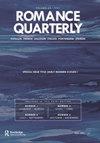Leveling the world: Metaphor and deshumanización in the cinematic dissolve
IF 0.2
3区 文学
0 LITERATURE, ROMANCE
引用次数: 0
Abstract
Abstract José Ortega y Gasset’s essay “La deshumanización del arte” (1924) describes the distinct mode of perception that he attributed to the modern artist. According to Ortega, the avant-garde artist views all entities—from inanimate objects to human beings—strictly from the outside, perceiving only the “lights, shadows and chromatic values” that constitute an entity’s visible surface. This form of seeing engenders a leveled vision of the world in which the presence or absence of inner experience is irrelevant, and subjects and objects are thus rendered equivalent. Ortega and likeminded avant-garde poets considered metaphor to embody this mode of vision because it posits similarity among patently disparate beings and things; through metaphor, the differences in category that separate two compared entities are shown to be less significant than their shared esthetic qualities. This article investigates the relevance of the cinematic technique of dissolve—in which two images are briefly superimposed so that one appears to change smoothly into the other—to Ortega’s concept of dehumanized metaphor. I examine the role of the dissolve in Un chien andalou (1929) in order to demonstrate the function that it served for Luis Buñuel, Salvador Dalí and other filmmakers inclined toward Orteguian dehumanization. By joining together and implicitly equalizing human beings and things on the basis of their visual likeness, the dissolve employed the same strategy as verbal metaphor but was able to convey more vividly the lack of differentiation between subjects and objects.夷平世界:隐喻和deshumanización在电影溶解
约瑟夫·奥尔特加·伊·加塞特的文章“La deshumanización del arte”(1924)描述了他归因于现代艺术家的独特感知模式。根据奥尔特加的说法,前卫艺术家严格地从外部观察所有实体——从无生命的物体到人类——只感知构成实体可见表面的“光、影和色彩值”。这种形式的观察产生了一种对世界的平视,在这种平视中,内在体验的存在或缺失是无关紧要的,主体和客体因此被视为等同的。奥特加和与他志同道合的先锋派诗人认为隐喻体现了这种视觉模式,因为它假设了明显不同的存在和事物之间的相似性;通过隐喻,区分两个比较实体的范畴差异不如它们共同的审美品质重要。本文探讨了电影技术的相关性,其中两个图像被短暂地叠加,使其中一个看起来平滑地变成另一个奥尔特加的非人性化隐喻的概念。我考察了在1929年的影片《我在安达卢》中溶解的作用,以证明它对路易斯Buñuel、萨尔瓦多Dalí和其他倾向于奥尔特古式非人性化的电影制作人所起的作用。通过在视觉相似性的基础上将人与物联系在一起并含蓄地平等化,消解采用了与语言隐喻相同的策略,但能够更生动地传达主体与客体之间缺乏区分。
本文章由计算机程序翻译,如有差异,请以英文原文为准。
求助全文
约1分钟内获得全文
求助全文
来源期刊

ROMANCE QUARTERLY
LITERATURE, ROMANCE-
CiteScore
0.30
自引率
50.00%
发文量
18
期刊介绍:
Lorca and Baudelaire, Chrétien de Troyes and Borges. The articles in Romance Quarterly provide insight into classic and contemporary works of literature originating in the Romance languages. The journal publishes historical and interpretative articles primarily on French and Spanish literature but also on Catalan, Italian, Portuguese, and Brazilian literature. RQ contains critical essays and book reviews, mostly in English but also in Romance languages, by scholars from universities all over the world. Romance Quarterly belongs in every department and library of Romance languages.
 求助内容:
求助内容: 应助结果提醒方式:
应助结果提醒方式:


